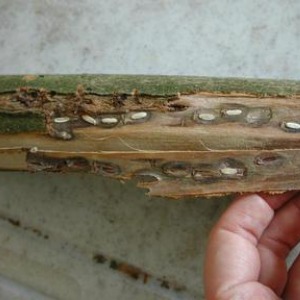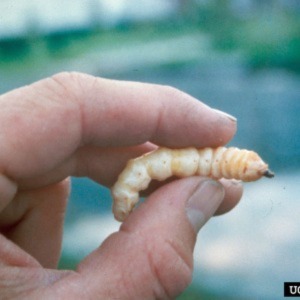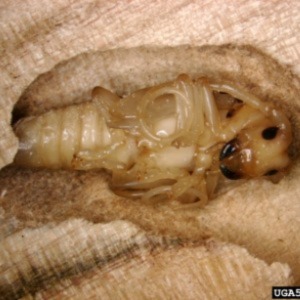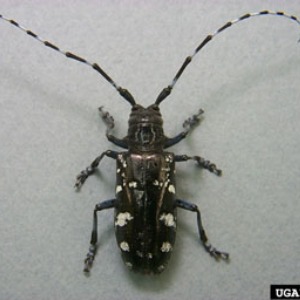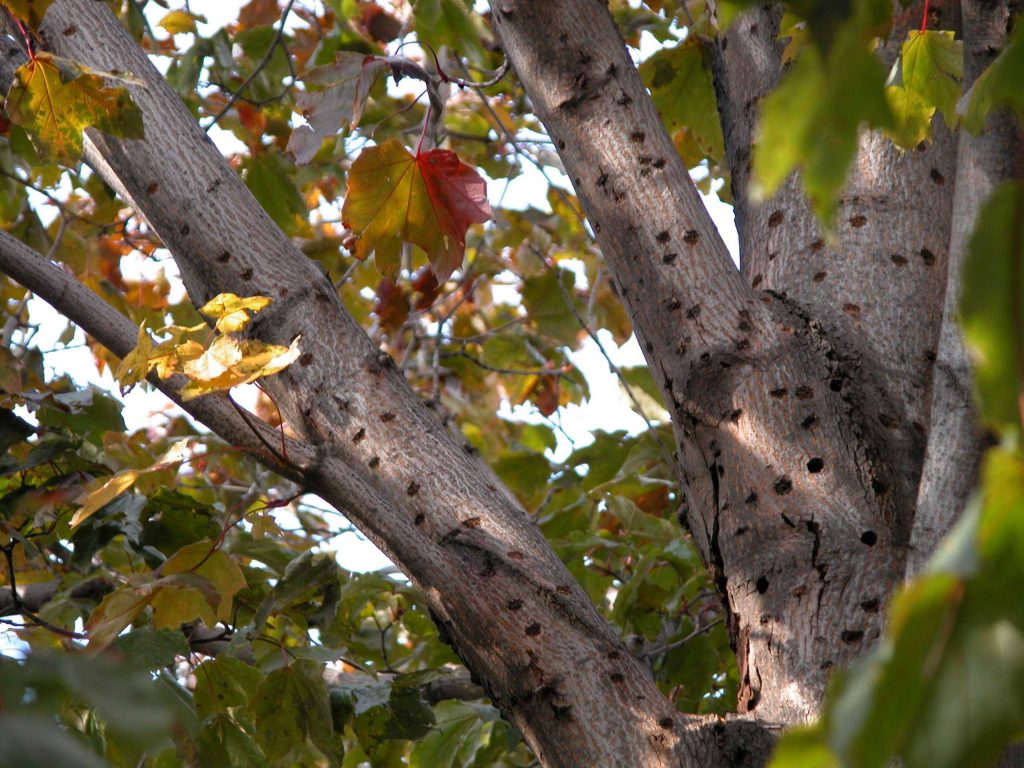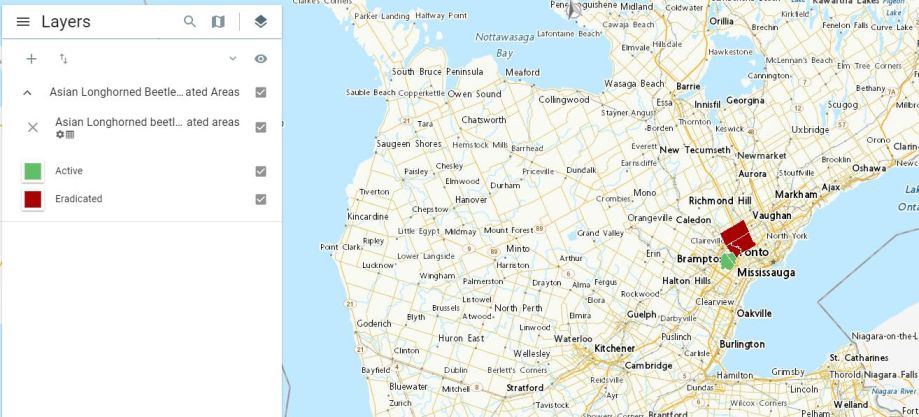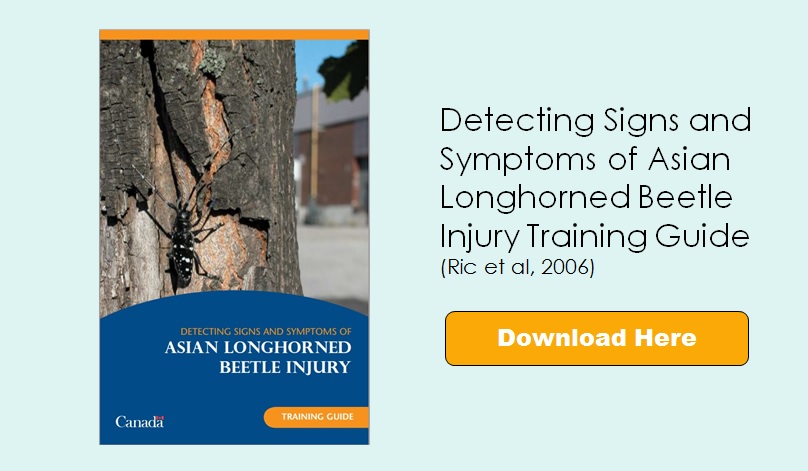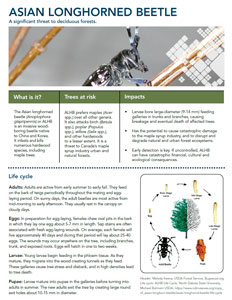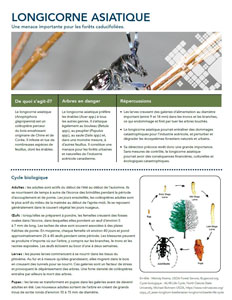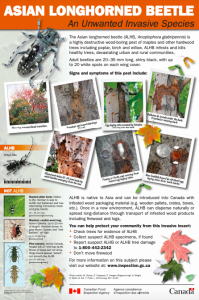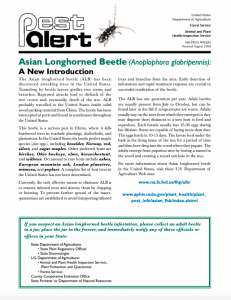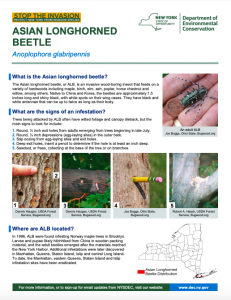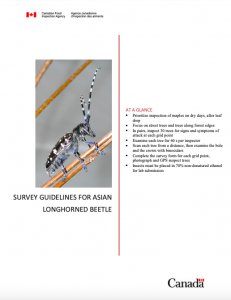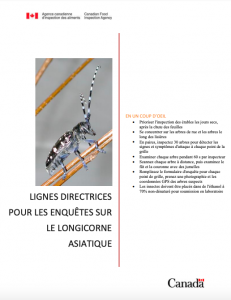Asian longhorned beetle (ALHB) has been eradicated from the cities of Mississauga and Toronto in the province of Ontario. After five years of surveys with no detection of this plant pest, the Asian Long-horned Beetle Infested Place Order has been repealed effective June 9, 2020.
Asian Longhorned Beetle (Anoplophora glabripennis)
French common name: Longicorne asiatique
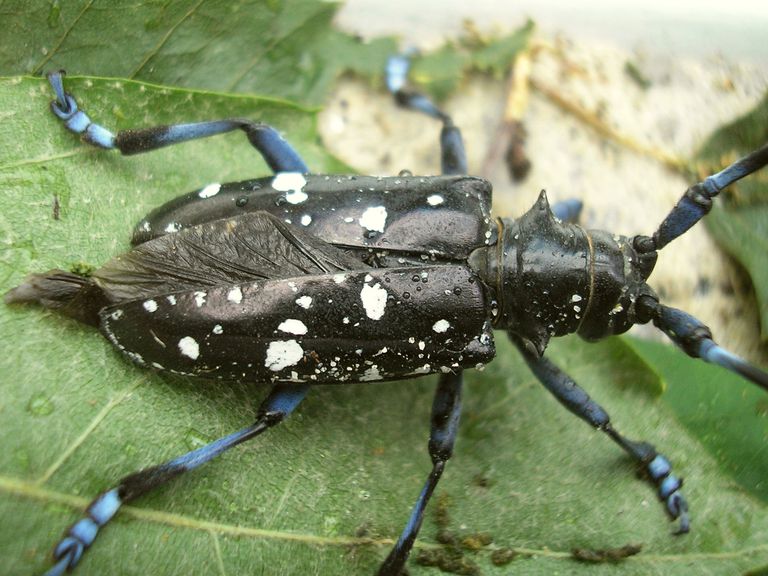
Asian longhorned beetle has irregular white spots along its body.
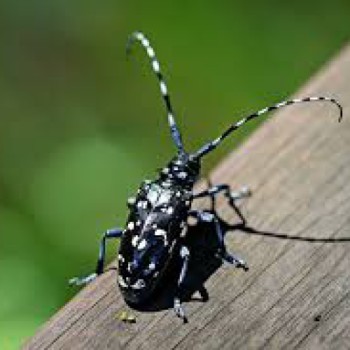
ALB attack maple and other hardwood trees.
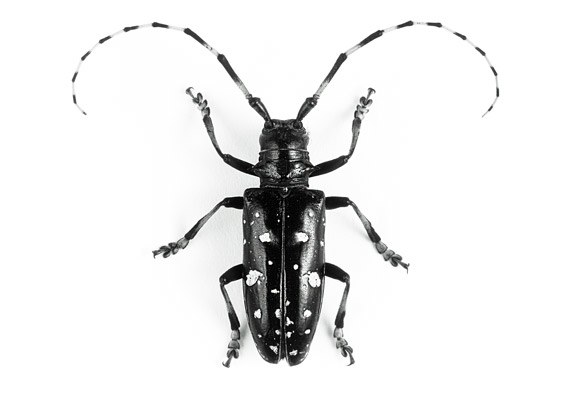
ALB are shiny and black with prominent, irregular white spots, 2-4 cm in length.
Order: Coleoptera
Asian longhorned beetle (ALB) was first discovered in North America at several ports in the early 1990s. ALB was detected in the Toronto, Ontario area in 2003 and quick action lead to eradication of the pest over the following years. Unfortunately, a new infestation was discovered in Mississauga, Ontario in 2013. After five years of surveys with no detection of this plant pest, the Asian Long-horned Beetle Infested Place Order has been repealed effective June 9, 2020.
The destructive nature and wide variety of hardwood tree hosts of the ALB make it especially concerning for Canada. The ALB readily attacks and kills maple trees, which are widespread across natural and urban areas in Canada. Maple trees are culturally and economically important to Canadians, and the loss of this species could have devastating impacts.
It is important to remain vigilant as individual detections (not established populations) do occur.
Physical Description
Adult: Shiny black with prominent, irregular white spots, 2-4 cm in length. It has distinct bluish-white legs and long black and white segmented antennae. In Canada, the adult ALB can easily be mistaken for several native beetles that look similar, such as the white-spotted sawyer (Monochamus scutellatus). (OFAH/OMNR Invading Species Awareness Program, 2012)
Larvae: Round, grub-like, and creamy white-coloured.

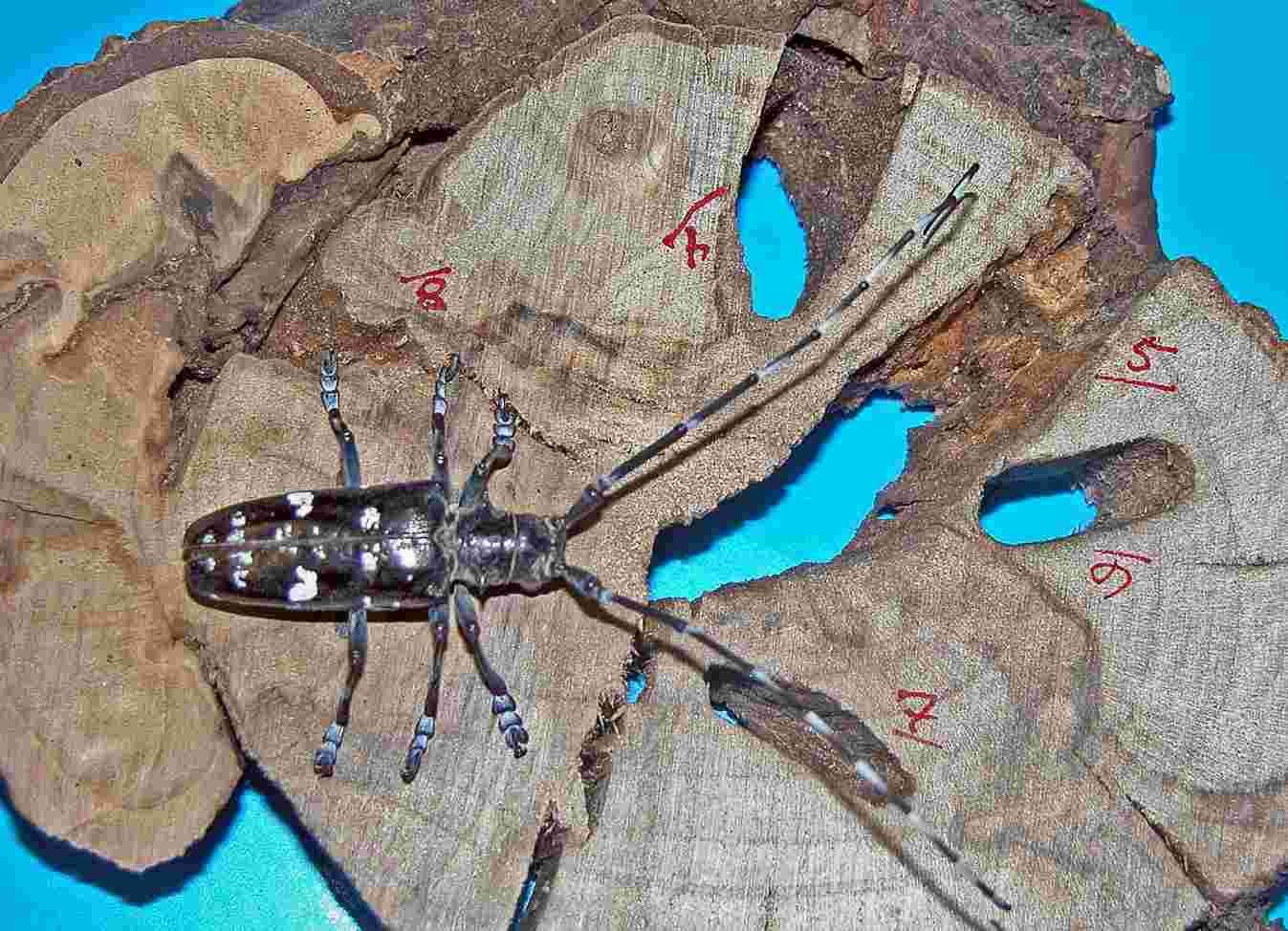
Photo: Taylor Scarr, OMNRF
Life Cycle
Female adult beetles chew a shallow, oval-shaped pit into the bark or branches of a host tree to deposit an egg. Single eggs will be laid at multiple sites, with the possibility of one female laying up to 100 eggs. Eggs resemble grains of rice, and could take a week to several months to develop into larvae. The developed larvae initially feed in the cambium region under the bark, and eventually tunnel deeper into the tree. The tunnels created by the larvae hinder the tree’s ability to transport water and nutrients and eventually kills it. The larvae overwinter in the tree, until pupation occurs in April or May. Adult beetles emerge from late May to July, through large (1.5-2 cm diameter) exit holes in the bark (City of Toronto, 2015). The rate of development depends on temperatures during the growing season; therefore, a portion of the population can take two years, rather than one, to complete its life cycle. (OMRNF, 2014)

“Photos: (1)Melody Keena, USDA Forest Service, Bugwood.org, (2) Kenneth R. Law, USDA APHIS PPQ, Bugwood.org (3) Pennsylvania Department of Conservation and Natural Resources – Forestry , Bugwood.org and (4) Donald Duerr, USDA Forest Service, Bugwood.org
In Ontario, full development of ALB populations has been observed on maples (Acer spp.), poplars (Populus spp.), birches (Betula spp.), and willows (Salix spp.); however, the beetle has the potential to infest a wide range of other hardwood species (OMNRF, 2014). 
Signs of infestation by ALB include (City of Toronto, 2015):
- Oval-shaped egg pits dug on trunk, branches, or exposed roots
- Leaking sap
- Large round exit holes (1.5-2 cm diameter)
- Yellowing leaves
- Premature leaf drop
- Branch dieback
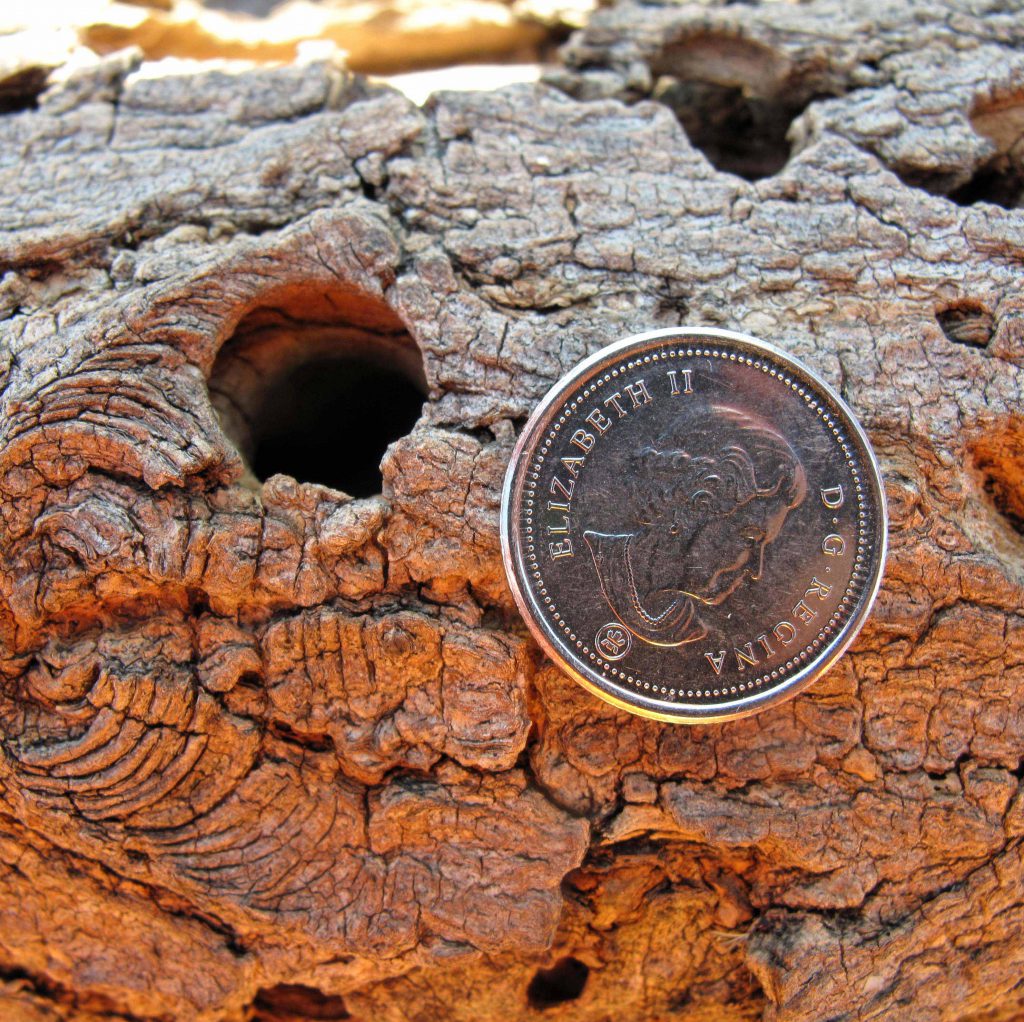 Photo: Aspen Zeppa, OMNRF |
Photo: Aspen Zeppa, OMNRF |
Asian longhorned beetles create large (1.5 – 2 cm diameter) exit holes on the trunk and branches of host trees.
Asian longhorned beetle (ALB) is an insect native to several Asian countries, including China and Korea. The beetle was introduced into Canada when infested wood from plantations was used as packaging material for cargo being shipped to North America. ALB was first detected in the US and Canada in the early 1990s at several ports. To date, 15 states, British Columbia, and Ontario have reported ALB interceptions (City of Toronto, 2015). Currently there are ALB infestations in only three states (Ohio, New York, and Massachusetts) and in Ontario (see map, below). All ALB infestations are under active eradication programs.
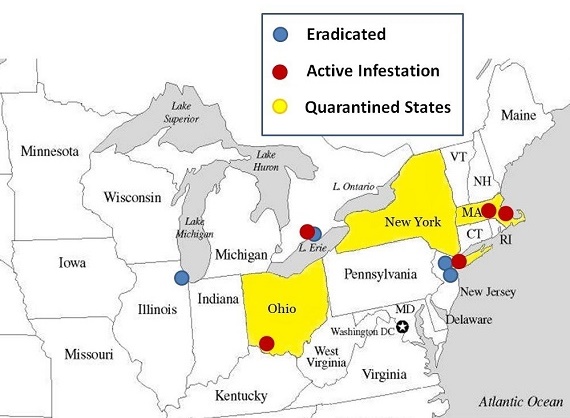

Map: Iowa Tree Pests website (2022) http://iowatreepests.com/alb_home.html
Locations of Asian longhorned beetle found since 1996. Note: The “active infestation” in the Greater Toronto Area is under an active eradication program with no recent detections.
The map below is the EDDMapS (Early Detection & Distribution Mapping System) Ontario distribution map for the Asian longhorned beetle as of May 2017. To see the current EDDMapS distribution map, click on the map below.
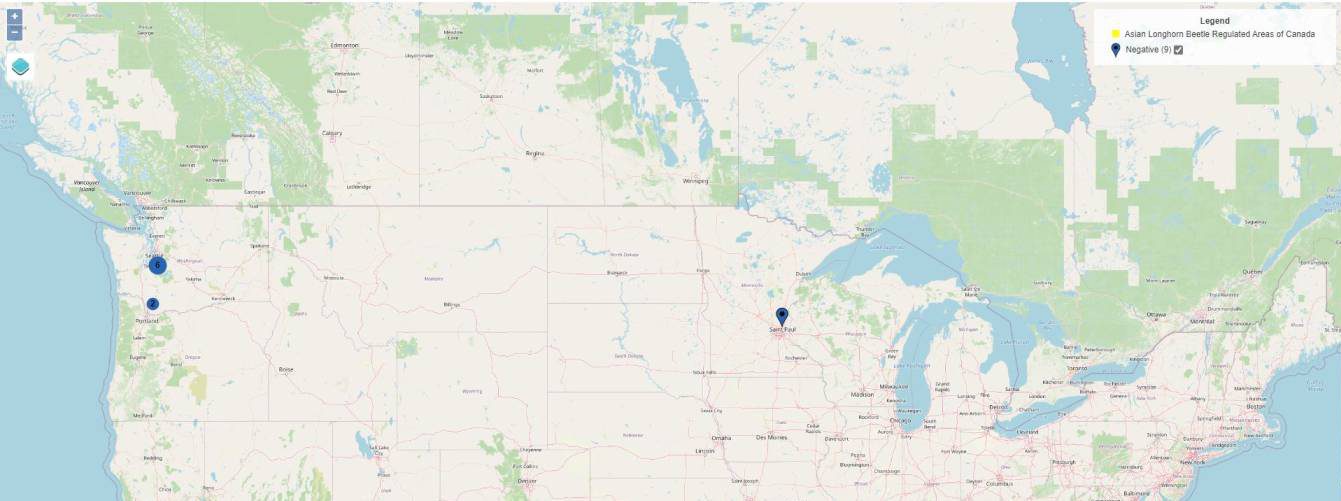

Map: EDDMapS. 2017. Early Detection & Distribution Mapping System. The University of Georgia – Center for Invasive Species and Ecosystem Health. Available online at http://www.eddmaps.org/; last accessed May 5, 2022.
There are restrictions on the movement of nursery stock, trees, logs, lumber, wood, wood chips and bark chips from trees identified as potential hosts of the ALB and firewood of all species in the regulated area (see map below). It is also recommended that potential host trees (maple, birch, poplar, willow, elm, horse chestnut, sycamore, katsura, mountain ash, silk tree, hackberry, and goldenrain tree) should not be planted within the regulated area until the ALB has been declared eradicated.
The Asian longhorned beetle regulated area
Map: CFIA (2022) Click on the map to see the current regulated areas.
The following Canadian Food Inspection Agency (CFIA) plant protection policies relate to the ALB:
In 2003, adult ALB were discovered in areas of Toronto and Vaughan. The Canadian Food Inspection Agency (CFIA) acted quickly to address the infestation. Many susceptible trees around the infested areas were removed in hopes of stopping the spread of the beetle. As a result of early detection and quick response, the spread of ALB was prevented and no beetles were detected within Ontario between 2007 and 2013 (OFAH/OMNR Invading Species Awareness Program, 2012). Unfortunately, a new infestation was detected in Mississauga in 2013.
Economic impacts
If the beetle spreads within Ontario and Canada, it can cause large reductions in wood supply and reduce the availability and quality of hardwood species to the forest industry. This would mean large revenue losses, as the hardwood forest industry is worth billions of dollars in wood products (NRCan, 2014). For instance, Canada’s commercial hardwood forests produce $11 billion in wood products annually (City of Toronto, 2015).
Also, as the beetle favours maple species, the damage and death it causes to these trees could greatly hurt the maple syrup industry, which is worth about $100 million each year in Canada (NRCan, 2014; City of Toronto, 2015).
Further, healthy forests support tourism and recreation, so damage to the natural environment could negatively impact these industries as
well.

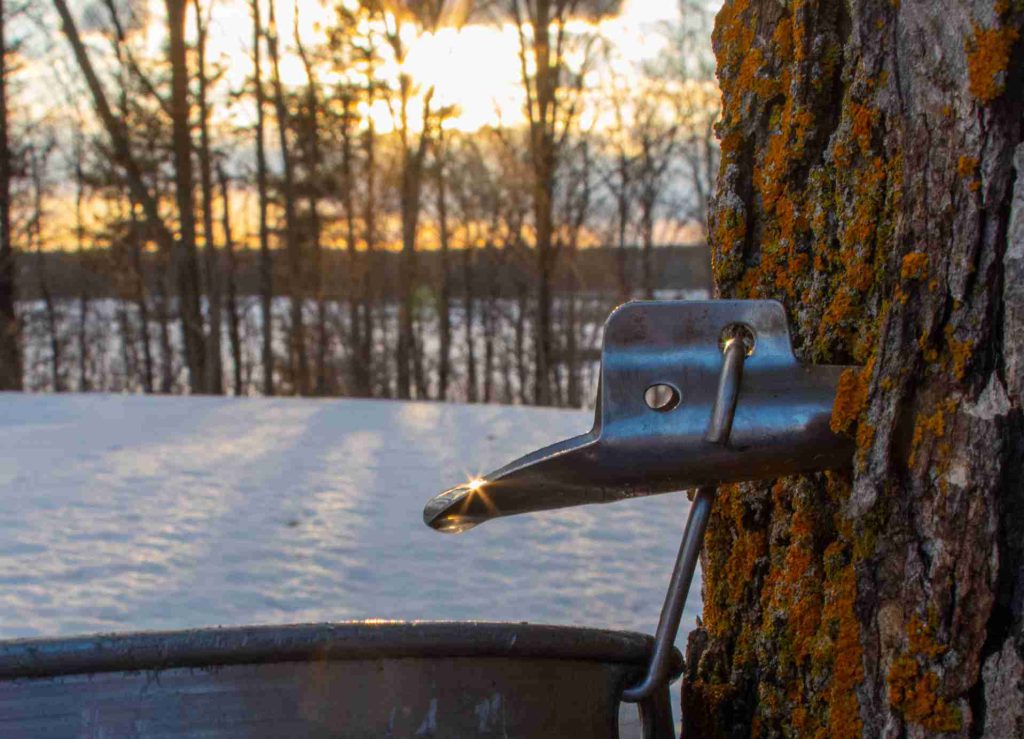
Photo: Gary, Adobe Stock Images
The Asian longhorned beetle, which attacks a wide range of hardwood tree species, including the sugar maple, threatens the $100 million maple syrup industry in Canada.
Ecological impacts
Since ALB has no effective predators in North America, it could cause great damage to native ecosystems if it is not contained. The hardwood species that the beetle attacks make up a large proportion of both natural and urban forest canopies across Canada. For example, in the City of Toronto, 42% of the street trees are preferred host species for the beetle and thus susceptible to its attack (City of Toronto, 2015).
In natural deciduous forests, hardwood species such as maple serve as a foundation species in their environment. These trees hold a disproportionate control over the structure and function of the ecosystem, and their loss can cause widespread ecological damage. According to Ellison et al. (2005), the loss of a foundation species from a forest can result in a disruption of fundamental ecosystem processes, such as decomposition rates, nutrient cycling, carbon sequestration, energy flow, and impacts adjacent aquatic ecosystems in riparian areas. If ALB is not contained, it has the potential to devastate Canadian forests, especially when combined with the damage caused by emerald ash borer and other invasive forest pests. Many species at risk are found within Ontario’s hardwood forests, so their survival is also at risk with this potential decline of forest health (City of Toronto, 2015).
Social impacts
Any widespread tree loss due to ALB has the potential to impact tourism and recreation values, due to the loss of aesthetic values that trees and forests possess.
Community quality of life, in both urban and rural areas, could also be reduced if ALB spreads and damages more hardwood trees in Ontario. These trees provide shade, increase aesthetic beauty, filter air and water pollutants, produce oxygen, and increase property values. Therefore, the loss of these trees would mean a decrease in these social benefits. In addition, the maple tree is a symbolic species in Canada, both on our landscape and on our flag. The loss of this species could have devastating social impacts in Canada.
If the Asian longhorned beetle establishes itself in Canada, a wide range of social activities that depend on healthy hardwood forests could be impacted, such as hiking, camping, and fall-colour tours.
Prevent
After its first detection in 2003, the CFIA implemented an eradication program in 2004 to quickly respond to the threat of ALB. First, a quarantine zone of about 150km2 was established around the infested trees where the beetle was discovered. This restricted the movement of wood and wood products out of this zone (NRCan, 2014).
Detect
If you have found a suspect Asian longhorned beetle and/or its habitat, download and complete the following sampling protocols:
- Survey Guidelines for Asian Longhorned Beetle (Anoplophora glabripennis) – ENGLISH
- Lignes directrices pour les enquêtes sur le longicorne asiatique (Anoplophora glabripennis) – FRANÇAIS
When conducting surveys in accordance with this protocol, please contact the CFIA so all partner activities can be tracked as part of the national surveillance efforts. Suspect finds should also be reported to the CFIA cfia.surveillance-surveillance.acia@canada.ca.
Respond and Control
Mechanical
All infested trees found between 2003 and 2004 were removed and the wood was chipped. In addition, another 12,500 nearby trees that were considered susceptible to infestation were also cut down and chipped (NRCan, 2014). This was done to prevent the further spread of the beetle. As trees were removed, full documentation of tree species, tree size, and signs and location of beetle attacks on each tree was carried out. This was done to develop a comprehensive understanding of the beetle’s behaviour in the Canadian context, to be used for future detection, training, and management (NRCan, 2014).
An infestation of ALB was detected in Mississauga, Ontario in 2013. Using knowledge gathered in the first eradication of the insect, an eradication plan was quickly put in place. Monitoring efforts concluded in 2020 when the Canadian Food Inspection Agency declared ALB had been eradicated from Mississauga and Toronto.
Towards successful eradication of the Asian longhorned beetle: Early detection & rapid response
When prevention is not possible, ‘early detection and rapid response’ is advocated as the best strategy to combat an introduced invasive species. As the name suggests, the success of this strategy depends on how early the species is detected, and how rapid and effective the response is. In some cases, when an invasive species is first detected in a forest or urban area, it has already spread much further than expected, and it may not be possible to eradicate. For example, when the emerald ash borer (EAB) was first detected in Windsor, Ontario in 2002, a quarantine barrier was established. The EAB attacks and kills >99% of ash trees, so an ‘ash-free zone’ was established where all potential host trees were removed in an attempt to stop EAB spread. Unfortunately, the EAB had already spread beyond the geographical range of this barrier long before the quarantine was established. Scientists now believe that EAB could have been present in Ontario up to 10 years prior to its initial detection. Even though the response was rapid, it was not effective at stopping the spread of the insect due to late detection.
In some cases, however, early detection and rapid response can be very effective and successful. This is best exemplified in the case of the Asian longhorned beetle (ALB). ALB was first detected in an industrial area north of Toronto in September 2003. ALB attacks and kills a wide range of native trees, including the symbolic maple tree. This one invasive species had the potential to impact tourism and social values, create losses in the billion dollar hardwood and maple syrup industries, and cause widespread and immeasurable impacts on native forests. Officials were already aware of the potential impacts of ALB on many of Canada’s native hardwood tree species, so were quick to make the decision to eradicate. Immediately, a 150 km2 quarantine zone was established around the initial detection site to restrict the movement of wood materials. By the following spring, 531 infested or likely infested trees were removed and destroyed, in addition to 12,500 high-risk trees in the regulated area.
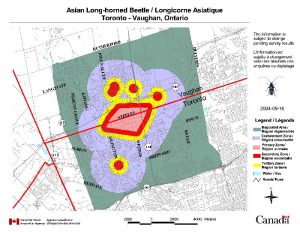
Map depicting the quarantine zone established to control and eradicate the spread of ALB detected in 2003. The map depicts red zones of primary and secondary infestation, surrounded by buffer and containment areas. 531 trees with signs of ALB, and an additional 12 500 ‘high-risk’ trees were removed from this area by 2008. Map: CFIA (2004)
After tree removal, the Canadian Forest Service and multiple survey crews continued to monitor trees within the regulated area looking for any signs of ALB. From 2004-2007, an additional 40 infested trees were detected and removed each year, less than 15 infested trees were found in 2007, and no infested trees were found for the remainder of the surveys (NRCAN, 2011). Over five years passed with no detectable signs of ALB in the area, and it was officially declared to be eradicated in April 2013 by the CFIA – a great success!
Unfortunately, the celebrations were short-lived. In December 2013, an adult beetle was collected and positively identified as ALB in an industrial area of Mississauga, outside of the original regulated area. Again, early detection of the new infestation allowed for rapid response by dedicated researchers and technicians. The area surrounding the detection was extensively surveyed, and technicians were able to locate two Norway maples and three Manitoba maples that showed signs of infestation. One of the Manitoba maples was heavily infested with over 900 exit holes!
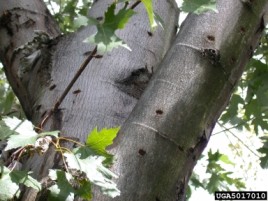
Photo: Pennsylvania Department of Conservation and Natural Resources bugwood.org. A tree showing damage from ALB
Over the remainder of the winter, extensive tree removal took place in the new infested area. Tree removal efforts focused on four preferred tree hosts for ALB: maple, poplar, willow, and birch. Roughly 7,500 trees were removed in an 800 m buffer surrounding known infested sites. Each tree that was removed was carefully inspected by researchers for signs of ALB damage and then destroyed. Throughout this process, 25 more infested trees and 17 suspect trees were discovered. A new 46 km2 regulated area was established surrounding the infestation (below), and again, it is prohibited to move any tree materials out of the area.
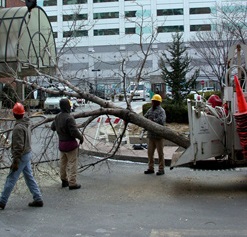 | 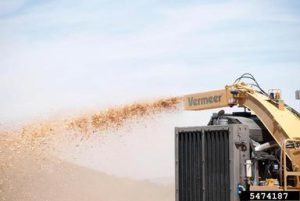 |
Photos: (1) Thomas B. Denholm, New Jersey Department of Agriculture, Bugwood.org and (2) USDA Forest Service – Forest Operations Research , USDA Forest Service, Bugwood.org.
Following positive detection of Asian longhorned beetle, trees identified to be infested or high-risk are removed and destroyed by chipping.
This area continues to be very closely monitored for any new signs of ALB, and if discovered, any suspect trees will be promptly removed and destroyed. This is the quick action that is required to control an invasive pest outbreak, and prevent the species from becoming established on the Canadian landscape. The intentional removal of host trees from these regulated areas is a labour-intensive and expensive operation, however these impacts are only a small fraction of the potential economic, ecological, and social impacts created if the ALB were to permanently establish in Canada. With this continued effort, ALB can be successfully and permanently eradicated from Ontario.
You can help stop an Asian longhorned beetle invasion by:
- Never moving firewood, nursery stock, or other tree materials outside of regulated areas.
- Learn to identify the Asian longhorned beetle.
- Report any suspect ALB signs or symptoms – photos help! For more information on reporting an invasive species, click here!
- Spread the word! Tell your friends, family, and neighbours about the threat from ALB.
- Replant removed trees with a native non-host species. Contact your local forestry professionals for information on what to plant.
For more tips, check out the Forest Invasives Canada Quick Tips Page!
Fact Sheets
Research
Managing invasive populations of Asian longhorned beetle and citrus longhorned beetle: a worldwide perspective
longhorned beetle (CLB), Anoplophora chinensis (Forster)(Coleoptera: Cerambycidae), are
polyphagous xylophages native to Asia and are capable of killing healthy trees. ALB …
Asian longhorned beetle (Coleoptera: Cerambycidae), an introduced pest of maple and other hardwood trees in North America and Europe
urban and forest hardwood trees both where introduced and in parts of its native range.
Native to Asia, this beetle has hitchhiked several times in infested wood packaging used in …
Asian longhorned beetle Anoplophora glabripennis (Motschulsky): lessons learned and opportunities to improve the process of eradication and management
invasive species in North America and Europe. Known infestations currently exist in New
York, New Jersey, Chicago, Toronto, France, Austria and Germany. Because little was …
Current Research and Knowledge Gaps
Lorem ipsum dolor sit amet, consectetur adipiscing elit. Ut elit tellus, luctus nec ullamcorper mattis, pulvinar dapibus leo.
Further Reading
The Invasive Species Centre aims to connect stakeholders. The following information below link to resources that have been created by external organizations.

